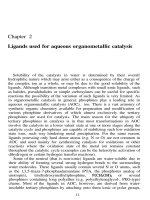Tài liệu Chapter 2: Ligands used for aqueous organometallic catalysis pdf
Bạn đang xem bản rút gọn của tài liệu. Xem và tải ngay bản đầy đủ của tài liệu tại đây (1.36 MB, 35 trang )
Chapter 2
Ligands used for aqueous organometallic catalysis
Solubility of the catalysts in water is determined by their overall
hydrophilic nature which may arise either as a consequence of the charge of
the complex ion as a whole, or may be due to the good solubility of the
ligands. Although transition metal complexes with small ionic ligands, such
as halides, pseudohalides or simple carboxylates can be useful for specific
reactions the possibility of the variation of such ligands is very limited. As
in organometallic catalysis in general, phosphines play a leading role in
aqueous organometallic catalysis (AOC), too. There is a vast armoury of
synthetic organic chemistry available for preparation and modification of
various phosphine derivatives of which almost exclusively the tertiary
phosphines are used for catalysis. The main reason for the ubiquity of
tertiary phosphines in catalysis is in that most transformations in AOC
involve the catalysts in a lower valent state at one or more stages along the
catalytic cycle and phosphines are capable of stabilizing such low oxidation
state ions, such way hindering metal precipitation. For the same reason,
ligands posessing only hard donor atoms (e.g. N or O) are not common in
AOC and used mainly for synthesizing catalysts for oxidations or other
reactions where the oxidation state of the metal ion remains constant
throughout the catalytic cycle (examples can be the heterolytic activation of
dihydrogen or certain hydrogen transfer reactions).
Some of the neutral (that is non-ionic) ligands are water-soluble due to
their ability of forming several strong hydrogen bonds to the surrounding
water molecules. These ligands usually contain several N or O atoms, such
as the l,3,5-triaza-7-phosphaadamantane (PTA, the phosphorus analog of
urotropin), tris(hydroxymethyl)phosphine, or several
phosphines containing long polyether (e.g. polyethyleneglycol-, PEG-type)
chains. Most of the ligands in AOC, however, are derived from water-
insoluble tertiary phosphines by attaching onto them ionic or polar groups,
11
12
Chapter 2
namely sulfonate, sulfate, phosphonate, carboxylate, phenolate, quaternary
ammonium and phosphonium, hydroxylic, polyether, or polyamide (peptide)
etc. substituents or a combination of those. This latter approach stems from
the philosophy behind research into AOC in the early days when the aim
was to “transfer” efficient catalytic processes, like hydroformylation, from
the homogeneous organic phase into an aqueous/organic biphasic system
simply by rendering the catalyst water soluble through proper modification
(e.g. sulfonation) of its ligands. Although this approach is still useful, so
much more is known today of the specific characteristics and requirements
of the processes in AOC that tayloring the ligands (and by this way the
catalysts) to the particular chemical transformation in aqueous or biphasic
systems is not only a more and more manageable task but a drive at the same
time for synthesis of new compounds for specific use in aqueous
environment.
In the following few sections we shall now review the most important
water-soluble ligands and the synthetic methods of general importance. It
should be noted, that in many cases only a few examples of the numerous
products available through a certain synthetic procedure are shown in the
tables and the reader is referred to the literature for further details.
2.1 TERTIARY PHOSPHINE LIGANDS WITH
SULFONATE OR ALKYLENE SULFATE
SUBSTITUENTS
This class of compounds is comprised by far the most important ligands
in aqueous organometallic chemistry. The main reasons for that are the
following:
sulfonated phosphines are generally well soluble in the entire pH-range
available for AOC and in their ionized form they are insoluble in
common non-polar organic solvents
in many cases these ligands can be prepared with straightforward
methods, for example by simple, direct sulfonation
the sulfonate group is deprotonated in a wide pH-range, its coordination
to the metal usually need not be considered i.e. the molecular state of the
catalyst is not influenced by coordination of the substituent
(important exceptions exist!)
they are sufficiently stable under most catalytic conditions.
Due to these reasons both in the early attempts in academic research and
in the first successful industrial process in AOC sulfonated phosphines were
used as ligands (TPPMS and TPPTS, respectively). A detailed survey of the
sulfonated ligands is contained in Table 1 and in Figures 1-5.
Ligands used for aqueous organometallic catalysis
13
2.1.1 Direct sulfonation
Fuming sulfuric acid (oleum) of 20% strength is suitable for
preparation of monosulfonated products [1-3] while for multiple sulfonation
30% (or more) is required [4-10]. The phosphine is dissolved in cold
oleum with protonation of the phosphorus atom therefore in cases when the
phenyl rings are directly attached to the phosphorus (e.g. triphenylphosphine
or the bis(diphenylphosphino)alkanes) sulfonation takes place in the 3-
position.
For monosulfonation of the reaction mixture can be heated for a
limited time [1-3] while multiple sulfonation is achieved by letting the
solution stand at room temperature for a few days [4-10]. In this simplest
way of the preparation several problems may arise. Under the harsh
conditions of sulfonation there is always some oxidation of the phosphine
into phosphine oxide and phosphine sulfides are formed, too. Furthermore,
selective preparation of TPPMS (
1
) or TPPDS (
2
) requires optimum
reaction temperature and time and is best achieved by constantly monitoring
the reaction by NMR [10] or HPLC [7]. Even then, the product can be
contaminated with unreacted starting material. However,
1
can be freed of
both the non-sulfonated and the multiply sulfonated contaminants by simple
methods, and in the preparation of TPPTS (
3
) contamination with
1
or
2
is usually not the case. Direct sulfonation with fuming sulfuric acid was
also used for the preparation of the chelating diphosphines 34-38
,
51
, 52
.
14
Chapter 2
Ligands used for aqueous organometallic catalysis
15
Most of the problems of side reactions can be circumvented by using a
mixture of unhydrous sulfuric acid (containing no free a powerful
oxidant) and orthoboric acid [4,8]. The superacidic nature of this sulfonation
mixture ensures complete protonation and the lack of free excludes the
possibility of oxidation. In addition, the number and position of the
sulfonate groups can be more effectively controlled than by using oleum for
16
Chapter 2
the sulfonation and this method is the procedure of choice for
functionalization of more oxidation sensitive phosphines such as
13-17
,
42-
46
.
In cases where the phenyl ring is not directly attached to a protonated
phosphorus, sulfonation can be carried out in 95-100% i.e. with no
dissolved free
(
28
,
31
,
42
,
47
,
49-51
).
In these syntheses based upon direct sulfonation, the reaction mixture
should be neutralized at the appropriate reaction time; this is usually
achieved with concentrated NaOH or KOH solutions [1-3] with the
concomitant production of lots of inorganic sulfates. The less soluble
monosulfonated products can be crystallized and the raw products contain
or
The highly soluble multiply sulfonated phosphines are usually extracted
into an organic phase (toluene) from acidic aqueous solutions (at controlled
pH) as their amine salts; triisooctylamine is an effective agent [4]. The pure
sulfonates can then be rextracted to an aqueous phase of appropriate pH and
isolated by evaporation of the solvent (in some instances by freeze drying).
If necessary, purification of the phosphines can be achieved by
recrystallization (
1
) or gel-permeation chromatography (
2
,
3
) the latter being
a generally useful method for obtaining pure ligands and complexes [4,19].
Quaternary ammonium salts of the sulfonated phosphines can be prepared
by extracting aqueous solutions of the Na- or K-salts with a toluene solution
of the appropriate salt [24].
In a different approach [11] to access pure products, the use of strong
oleum (65% ) for sulfonation of resulted in quantitative formation
of TPPTS oxide. This was converted to the ethyl sulfoester through the
reaction of an intermediate silver sulfonate salt (isolated) with iodoethane.
Reduction with in toluene/THF afforded tris(
3
-
ethylsulfonatophenyl)phosphine which was finally converted to pure 3 with
NaBr in wet acetone. In four steps the overall yield was 40% (for )
which compares fairly with other procedures to obtain pure TPPTS. Since
phosphine oxides are readily available from easily formed quaternary
phosphonium salts this method potentially allows preparation of a variety of
sulfonated phosphines (e.g. ).
2.1.2 Nucleophilic phosphinations, Grignard-reactions and
catalytic cross-coupling for preparation of sulfonated
phosphines
primary and secondary phosphines can be deprotonated in the
superbasic KOH(solid)/DMSO media [15,16,25]. Nucleophilic aromatic
substitution of fluorine in substituted fluorobenzenes with the resulting
Ligands used for aqueous organometallic catalysis
17
phosphide affords a wide range of primary, tertiary or secondary
phosphines, including
4-12
, having the sulfonate group in the 2- or 4-
position or in both. Such sulfonated phosphines are inaccessible by direct
sulfonation.
18
Chapter 2
Note also, that 10 is chiral at the phosphorus; this compound and its
analogs can easily be prepared starting, for example, from
12
.
The reaction of alkali metal phosphides with appropriate halides,
sultones or cyclic sulfates is a general method for preparation of a variety of
tertiary phosphines useful in aqueous organometallic catalysis. These
Ligands used for aqueous organometallic catalysis
19
phosphides can be generated in reactions of Li, K or Na with phosphorus
halides (e.g. ) in THF or from a suitable phosphine such as in
dioxane, dimethoxyethane or in liquid ammonia.
pTPPMS (
4
) has long been known [13] as the side product of the
preparation of l,4-bis(diphenylphosphino)benzene. In addition to its
synthesis from with the KOH/DMSO method [15], it can also be
obtained in the reaction of (from ) and potassium p-F-
benzenesulfonate in refluxing THF [14]. oTPPMS (
7
) and several
(
18
) were also obtained this way [20-22].
The borane adducts of phosphines having hydrogen, methyl or methylene
groups adjacent to the phosphorus can be easily deprotonated by strong
bases and the resulting anions react with various nucleophiles affording
borane-protected tertiary phosphines as air stable, crystalline materials [23].
Quantitative deprotection of the phosphorus can be achieved by treatment
with morpholine at 110 °C followed by evaporation to dryness. Dissolution
of the solid residue and addition of THF results in precipitation of the
products such as -among others-
19
.
Sultones are useful starting materials for the preparation of various
sulfoalkyl- (
18
,
20
) or sulfoarylphosphines (
7
) when reacted with the
appropriate alkali metal phosphide [20]. Reaction of the homologous alkyl-
1,2-sultones ( to ) with tris(2-pyridylphosphine) afforded highly water
soluble betains (
30
) [21].
Cyclic sulfates can be obtained from diols or polyols in the reaction of
the latter with followed by ruthenium catalyzed oxidation. These
sulfates readily react with yielding mono- and di-tertiary
diphenylphosphines having alkylene sulfate substituents (
54-57
). This is a
highly versatile procedure, since the starting diols are readily available and
the products are well soluble and fairly stable in neutral or slightly alkaline
aqueous solutions [57,105].
Hydroxy-phosphines undergo benzoylation with o-sulfobenzoic
anhydride in the presence of bases ( or BuLi) affording
sulfobenzoylated phosphine products. In such a way several mono- and
dihydroxy phosphines could be made soluble in water, exemplified by the
chiral bisphosphines
53
. It should be noted, that this general method allows
the preparation of water-soluble sulfonated derivatives of acid-sensitive
phosphines, such as DIOP, too, which are not accessible via direct
sulfonation [56].
The sulfonated atropisomeric bisphosphine MeOBIPHEP (
48
) was
prepared in a Grignard reaction of the appropriate bisphosphonic dichloride
and p-indolylsulfonamido-bromobenzene followed by reduction of the
phosphine oxide with [52]. The indolylsulfonyl protecting group was
20
Chapter 2
stable under the conditions of the Grignard reaction and the subsequent
reduction and was finally removed by mild alkaline hydrolysis.
The cross coupling of various substituted iodobenzenes and or
catalyzed by or in neat or aqueous organic
solvents (DMA, MeOH) is a versatile synthetic method for
preparation of secondary and tertiary phosphines; reaction of and
afforded in 78% yield [58].
2.1.3 Addition reactions
Michael addition of secondary phosphines on conjugated olefins is a
well known reaction in organic synthesis. Accordingly, addition of
diphenylphosphine on hydrophilic activated alkenes in or in
solution leads to various tertiary phosphines [33]; examples
include
1
,
25
,
27
. In order to avoid the formation of phosphine oxides and/or
the hydrolysis of some alkene derivatives (e.g. acryl esters) a small amount
of was used as base, and a small quantity of ditertbutylphenol was
Ligands used for aqueous organometallic catalysis
21
added to prevent polymerization.
25
was also prepared from
and
in THF[31].
In ethanol/water mixtures addition of sodium mercaptoalkane sulfonates
on vinyldiphenylphosphine proceeds smoothly at room temperature and
yields a variety of tertiary phosphines such as
24
. Interestingly, at the
beginning of the reaction the ethanolic solution of the vinylphosphine and
the aqueous solution of the educt comprise two separate phases and this is
favourable for the high yields obtained (59-97%) [30].
2.2 TERTIARY PHOSPHINE LIGANDS WITH
NITROGEN-CONTAINING SUBSTITUENTS
Phosphine ligands having an aliphatic, benzylic or aromatic nitrogen in
the organic moiety attached to phosphorus are usually well soluble in water
only under acidic conditions. Besides, coordination of the nitrogen donor
atom may further decrease aqueous solubility. Nonetheless, this class of
compounds offers an enormously wide choice of possible structures and
further funcionalization so that amino- or ammonium-substituted phosphines
proved their usefulness already at the dawn of aqueous organometallic
catalysis. Protonation or alkylation of these ligands lead to much higher
solubilities. In many cases, however, exclusive quaternization of the
nitrogen atoms requires protection of the phosphorus by oxidation or
complexation.
Synthetic procedures for the preparation of nitrogen-containing tertiary
phosphines comprise the methods described in some detail in the preceeding
sections
1.2
and
1.3
. Representative examples of these ligands are shown in
Figures 6 and 7. Several of these compounds are nowadays available
commercially. A detailed review on pyridylphosphines [59] appeared in
1993.
The first amino-phosphines used in AOC for studies of catalyst recovery
by aqueous extraction,
59
, were prepared by radical addition of on
dialkylallilamines [61]. Similar addition of diphenylphosphine on activated
alkenes [33] resulted in formation of a variety of phosphines including also
66
.
By far the most ubiquitous intermediates in synthesis of this class of
phosphines are the alkali metal phosphides which can be prepared by either
the KOH/DMSO method, by reaction of tertiary phosphines or
chlorophosphines with alkali metals, or in the reaction of BuLi with
appropriate secondary or tertiary phosphines. A number of the ligands in
Figures 6 and 7 were prepared this way (
60-69
,
72-74
).
22
Chapter 2
Ligands used for aqueous organometallic catalysis
23
Palladium catalyzed P-C cross coupling [58] between primary or
secondary phosphines and appropriate aryl iodides made possible the
preparation of several aminophenyl-phosphines with the general formula
70
and also the bisphosphine
71
.
Strongly basic cationic phosphine ligands
75
,
76
containing guanidino
functions were prepared either in the reaction of 3-
aminopropyldiphenylphosphine with 1H-pyrazole-l-carboxamide under
basic conditions in DMF [75] or by the addition of dimethylcyanamide to
the amino groups of tertiary (3-aminophenyl)phosphines in acidic medium
[70]. These phosphines (as acetate or chloride salts) are highly soluble in
water; in some cases the solubility reaches that of TPPMS. Another
noteworthy feature of these compounds that they are considerably less
sensitive to air oxidation then the anionic (e.g. sulfonated) phosphines.
reacts with the appropriate diol ditosylates yielding
the chiral phosphines
77-79
. These analogs of the well known Chiraphos,
BDPP (Skewphos) and DIOP can be made water soluble by protonation or
quaternization. Quaternization can be achieved with with the
phosphorus atoms protected by complexation to Rh(I) [76]. This method of
quaternization was originally introduced [77] to prepare
81
in its rhodium
complex. It is remarkable, that DIOP which is known to be acid sensitive
survives all these manipulations.
The aliphatic phosphine
(l,3,5-triaza-7-phosphaadamantane, PTA,
82
) can be easily prepared from
tris(hydroxymethyl)phosphine, formaldehyde and hexamethylenetetramine
[78,79]. This is an air-stable, small-size ligand similar in electronic and
steric properties to It is well soluble in water, probably due to
extensive hydrogen bonding to surrounding molecules. Protonation
( at 25°C [71]) and quaternization (e.g. with ) takes place
exclusively on the nitrogen atoms. Unlike most phosphine ligands used in
aqueous organometallic catalysis, PTA and its derivatives, including also its
metal complexes, usually crystallize well from aqueous solutions and this
property allowed the determination of a large number of structures by X-ray
crystallography.
24
Chapter 2
2.3 PHOSPHINE LIGANDS WITH CARBOXYL
SUBSTITUENTS
Tertiary phosphine ligands containing carboxyl substituents are
somewhat less investigated in aqueous organometallic chemistry than those
with or functions. There can be several reasons for this
relatively low-key performance. First, these compounds are usually weak or
only medium strong acids and therefore show appreciable water solubility
only above a certain pH (approx. 4-5). However, when dissolved in their
deprotonated form their carboxylate group is ready to coordinate transition
metals - a process which again leads to the decrease of solubility.
Nevertheless, several representatives of this large group of phosphines were
used as ligands in AOC and there are numerous general methods for their
preparation. The carboxylic acid substituent also allows further
functionalization.









